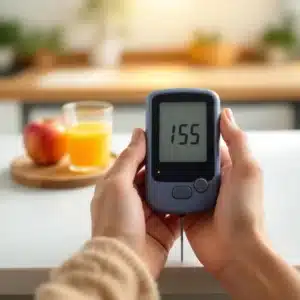How Diabetes Affects the Body: 10 Alarming Symptoms You Can’t Ignore

Introduction
Did you know that over 34 million Americans are living with diabetes, yet a staggering 28% of them are undiagnosed? This alarming statistic highlights the importance of understanding the symptoms and impacts of diabetes. As an entrepreneur or content creator, staying informed about health issues can inspire you to create awareness and promote well-being within your community. Diabetes is a chronic condition that affects how the body processes glucose, and its effects are often silent until they become severe. Early detection and understanding the symptoms can lead to better management and improved quality of life. Let’s dive deeper into how diabetes affects the body and the 10 alarming symptoms that you cannot afford to ignore.
1. How Diabetes Affects the Body
The Basics of Blood Sugar Regulation
Our bodies rely on glucose, a type of sugar, for energy. Insulin, a hormone produced by the pancreas, is critical in regulating the amount of glucose in our blood. In a healthy individual, insulin is released after a meal, allowing glucose to enter the cells, where it is used for energy. However, in people with diabetes, this process is disrupted. Type 1 diabetes leads to insufficient insulin production, while Type 2 diabetes results in the body’s resistance to insulin or insufficient insulin production.
Short-Term and Long-Term Effects of Diabetes
If left unmanaged, diabetes can lead to both short-term and long-term complications. In the short term, high blood sugar levels (hyperglycemia) can cause symptoms like excessive thirst, frequent urination, and fatigue. Long-term effects are more severe, including damage to the kidneys, eyes, nerves, and heart. Understanding and recognizing the early symptoms can help in seeking timely medical intervention, which is crucial for preventing these complications.
2. 10 Alarming Symptoms of Diabetes
Frequent Urination
One of the first signs of diabetes is frequent urination. High blood glucose levels can overwhelm the kidneys, which then try to get rid of the excess glucose through urine, leading to more frequent trips to the bathroom.
Excessive Thirst
Going hand in hand with frequent urination is excessive thirst. As the body tries to flush out the excess glucose, you may feel parched and find yourself drinking more fluids than usual.
Increased Hunger
Increased hunger is another symptom that may arise due to high blood sugar levels. Your body’s cells may not be receiving the glucose they need for energy, signaling the brain to demand more food.
Unexpected Weight Loss
Despite eating more, some individuals with undiagnosed diabetes may experience unexpected weight loss. This can happen when the body is not using glucose for energy and starts breaking down fat and muscle for fuel instead.
Fatigue and Weakness
Fatigue and weakness can result from cells not receiving enough glucose. Without proper energy, you may feel more tired and less able to perform tasks, both physically and mentally.
Blurred Vision
High blood sugar levels can lead to blurred vision as a result of the lens in the eye swelling. This is particularly concerning as it can affect daily activities, such as reading and driving.
Slow-Healing Wounds
Diabetes can also lead to slow-healing wounds. High blood sugar impedes the body’s ability to heal itself, so cuts, bruises, and other injuries may take longer to recover.
Tingling or Numbness in Hands and Feet
Tingling or numbness in hands and feet is a symptom of nerve damage, known as neuropathy, which can be a complication of diabetes. This can make it difficult to detect injuries, leading to a higher risk of complications.
Recurrent Infections
Diabetes can create an environment where infections are more likely to occur. Recurrent infections can affect the skin, urinary tract, and even the gums, and can be a sign that blood sugar levels are not well-managed.
Darkened Skin Areas
Some individuals may notice darkened skin areas, particularly in the armpits, neck, and elbows. This condition, known as acanthosis nigricans, is associated with insulin resistance and can be a sign of underlying diabetes.
3. Frequently Asked Questions
What are the different types of diabetes?
Diabetes primarily has three types: Type 1, Type 2, and Gestational diabetes. Type 1 diabetes is an autoimmune condition where the body attacks its own insulin-producing cells. Type 2 diabetes is characterized by insulin resistance or inadequate insulin production. Gestational diabetes occurs during pregnancy and can lead to complications for both mother and child.
How can diabetes be diagnosed?
Diabetes can be diagnosed through various tests, including the fasting plasma glucose test, the oral glucose tolerance test, and the hemoglobin A1c test. These tests measure the levels of glucose in the blood and can help identify whether a person has prediabetes or diabetes.
What complications can arise from untreated diabetes?
Untreated diabetes can lead to a range of complications, including cardiovascular disease, kidney failure, nerve damage, and vision loss. Early detection and management are crucial to preventing these complications.
Are there any lifestyle changes that can help manage diabetes?
Yes, lifestyle changes can significantly impact the management of diabetes. A balanced diet, regular exercise, weight management, and quitting smoking are all effective strategies for controlling blood sugar levels and improving overall health.
Can diabetes be cured?
While there is currently no cure for diabetes, it can be managed effectively with medication, lifestyle changes, and monitoring. Maintaining a healthy lifestyle and following a healthcare provider’s guidance can help individuals with diabetes live full, active lives.
4. Conclusion
Understanding the symptoms of diabetes is essential, not just for those at risk, but for anyone looking to promote health and well-being in their community. Early detection and management of diabetes can drastically reduce the risk of complications, leading to a better quality of life. If you or someone you know is experiencing any of the symptoms discussed, it is crucial to seek professional help. A healthcare provider can provide a proper diagnosis and guidance on management strategies, empowering individuals to take control of their health. Remember, you are not alone in this journey; support is available, and education is key.
For further reading, consider the following resources:
- 1. “Diabetes Mellitus and Cardiovascular Complications” – NCBI
- 2. “Type 2 Diabetes Mellitus: Pathophysiology and Management” – Wiley Online Library
- 3. “The Global Burden of Diabetes Mellitus” – Springer
5. Call to Action
If you found this article informative, please share your experiences or questions in the comments below..subscribe to our newsletter for more content on health and well-being. Together, let’s spread awareness about diabetes and support those affected by this condition.


